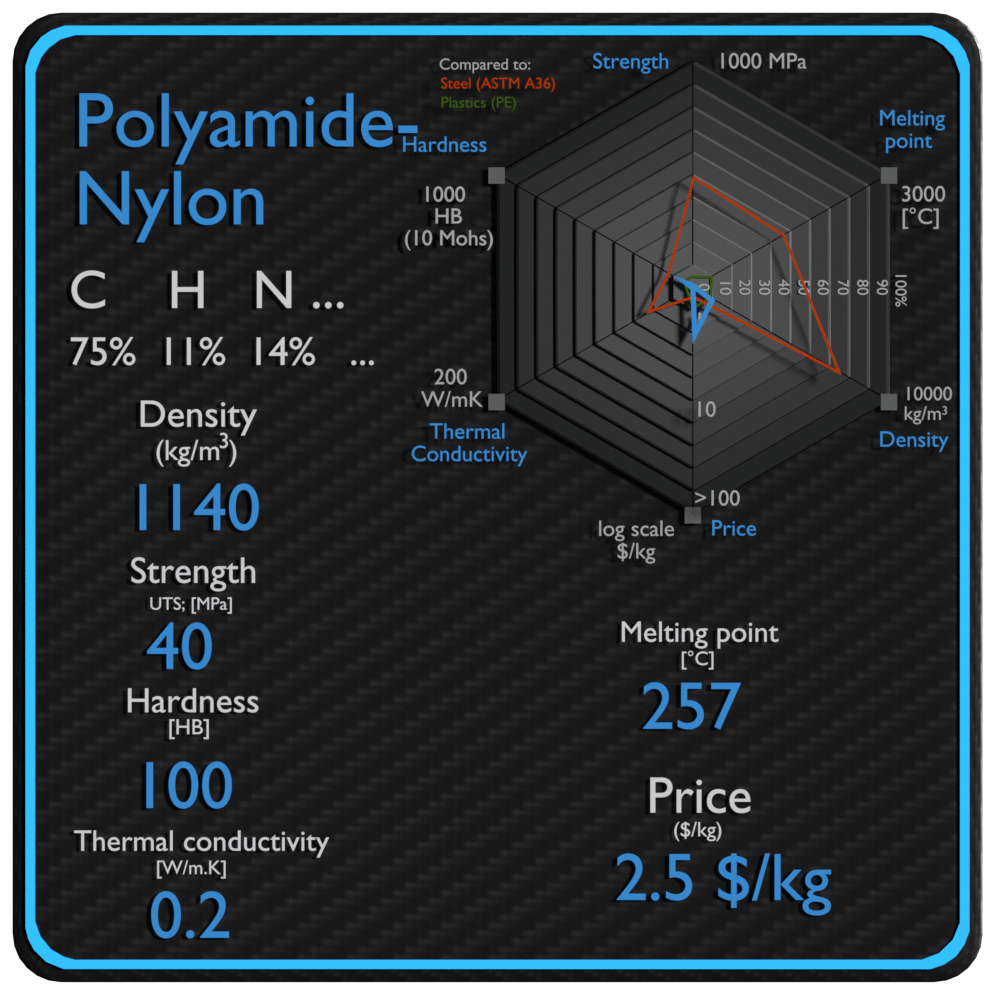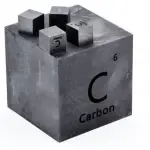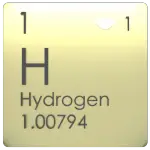About Polyamide – Nylon
A polyamide is a polymer with repeating units linked by amide bonds. Artificially made polyamides can be made through step-growth polymerization or solid-phase synthesis yielding materials such as nylons, aramids, and sodium poly. Nylon is a crystalline polymer with high modulus, strength, and impact properties, and low coefficient of friction and resistance to abrasion. A variety of commercial nylons are available, including nylon 6, nylon 11, nylon 12, nylon 6,6, nylon 6,10, and nylon 6,12. Nylon fibers do have a tendency to pick up a static charge, so antistatic agents are often added for carpeting and other applications.

Summary
| Name | Polyamide – Nylon |
| Phase at STP | solid |
| Density | 1140 kg/m3 |
| Ultimate Tensile Strength | 40 MPa |
| Yield Strength | N/A |
| Young’s Modulus of Elasticity | 2.9 GPa |
| Brinell Hardness | 100 BHN |
| Melting Point | 257 °C |
| Thermal Conductivity | 0.2 W/mK |
| Heat Capacity | 1500 J/g K |
| Price | 2.5 $/kg |
Composition of Polyamide – Nylon
Nylons, also known as polyamides, are synthesized by condensation polymerization methods, often an aliphatic diamine and a diacid. Although the materials possess a wide range of properties, they all contain the amide (-CONH-) linkage in their backbone.
Applications of Polyamide – Nylon
Nylons can be used as gears, cams, rollers, bearings, nuts and bolts, power tool housings, electrical connectors, combs, coil formers, fuel tanks for cars, kitchen utensils.
Mechanical Properties of Polyamide – Nylon
Strength of Polyamide – Nylon
In mechanics of materials, the strength of a material is its ability to withstand an applied load without failure or plastic deformation. Strength of materials basically considers the relationship between the external loads applied to a material and the resulting deformation or change in material dimensions. In designing structures and machines, it is important to consider these factors, in order that the material selected will have adequate strength to resist applied loads or forces and retain its original shape.
Strength of a material is its ability to withstand this applied load without failure or plastic deformation. For tensile stress, the capacity of a material or structure to withstand loads tending to elongate is known as ultimate tensile strength (UTS). Yield strength or yield stress is the material property defined as the stress at which a material begins to deform plastically whereas yield point is the point where nonlinear (elastic + plastic) deformation begins. In case of tensional stress of a uniform bar (stress-strain curve), the Hooke’s law describes behaviour of a bar in the elastic region. The Young’s modulus of elasticity is the elastic modulus for tensile and compressive stress in the linear elasticity regime of a uniaxial deformation and is usually assessed by tensile tests.
See also: Strength of Materials
Ultimate Tensile Strength of Polyamide – Nylon
Ultimate tensile strength of Polyamide – Nylon is 40 MPa.
Yield Strength of Polyamide – Nylon
Yield strength of Polyamide – Nylon is N/A.
Modulus of Elasticity of Polyamide – Nylon
The Young’s modulus of elasticity of Polyamide – Nylon is 2.9 GPa.
Hardness of Polyamide – Nylon
In materials science, hardness is the ability to withstand surface indentation (localized plastic deformation) and scratching. Brinell hardness test is one of indentation hardness tests, that has been developed for hardness testing. In Brinell tests, a hard, spherical indenter is forced under a specific load into the surface of the metal to be tested.
The Brinell hardness number (HB) is the load divided by the surface area of the indentation. The diameter of the impression is measured with a microscope with a superimposed scale. The Brinell hardness number is computed from the equation:
Brinell hardness of Polyamide – Nylon is approximately 100 BHN (converted).
See also: Hardness of Materials
Thermal Properties of Polyamide – Nylon
Polyamide – Nylon – Melting Point
Melting point of Polyamide – Nylon is 257 °C.
Note that, these points are associated with the standard atmospheric pressure. In general, melting is a phase change of a substance from the solid to the liquid phase. The melting point of a substance is the temperature at which this phase change occurs. The melting point also defines a condition in which the solid and liquid can exist in equilibrium. For various chemical compounds and alloys, it is difficult to define the melting point, since they are usually a mixture of various chemical elements.
Polyamide – Nylon – Thermal Conductivity
Thermal conductivity of Polyamide – Nylon is 0.2 W/(m·K).
The heat transfer characteristics of a solid material are measured by a property called the thermal conductivity, k (or λ), measured in W/m.K. It is a measure of a substance’s ability to transfer heat through a material by conduction. Note that Fourier’s law applies for all matter, regardless of its state (solid, liquid, or gas), therefore, it is also defined for liquids and gases.
The thermal conductivity of most liquids and solids varies with temperature. For vapors, it also depends upon pressure. In general:
Most materials are very nearly homogeneous, therefore we can usually write k = k (T). Similar definitions are associated with thermal conductivities in the y- and z-directions (ky, kz), but for an isotropic material the thermal conductivity is independent of the direction of transfer, kx = ky = kz = k.
Polyamide – Nylon – Specific Heat
Specific heat of Polyamide – Nylon is 1500 J/g K.
Specific heat, or specific heat capacity, is a property related to internal energy that is very important in thermodynamics. The intensive properties cv and cp are defined for pure, simple compressible substances as partial derivatives of the internal energy u(T, v) and enthalpy h(T, p), respectively:
where the subscripts v and p denote the variables held fixed during differentiation. The properties cv and cp are referred to as specific heats (or heat capacities) because under certain special conditions they relate the temperature change of a system to the amount of energy added by heat transfer. Their SI units are J/kg K or J/mol K.
Properties and prices of other materials
material-table-in-8k-resolution











